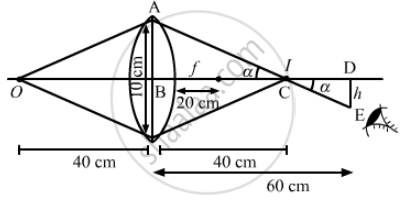Advertisements
Advertisements
प्रश्न
A point object O is placed on the principal axis of a convex lens of focal length f = 20 cm at a distance of 40 cm to the left of it. The diameter of the lens is 10 cm. An eye is placed 60 cm to right of the lens and a distance h below the principal axis. The maximum value of h to see the image is
विकल्प
0
2.5 cm
5 cm
10 cm.
उत्तर
2.5 cm
As the focal length of the lens is 20 cm and object distance is 40 cm from the lens, the image is formed at the centre of curvature at the right side of the lens.
From right angled triangle ABC,
\[\tan\alpha = \frac{AB}{BC}\]
\[\tan\alpha = \frac{5}{40}\]
\[\alpha = \tan^{- 1} \left( \frac{5}{40} \right)\]
and from right angled triangle, we have:
\[\tan\alpha = \frac{AB}{BC}\]
\[\tan\alpha = \frac{5}{40}\]
\[\alpha = \tan^{- 1} \left( \frac{5}{40} \right)\]
and from right angled triangle, we have:
\[\tan\alpha = \frac{AB}{BC}\]
\[\tan\alpha = \frac{5}{40}\]
\[\alpha = \tan^{- 1} \left( \frac{5}{40} \right)\]
Putting the value of angle alpha, we get:
\[\tan\left( \tan^{- 1} \left( \frac{5}{40} \right) \right) = \frac{h}{20}\]
\[\frac{5}{40} = \frac{h}{20}\]
\[ \Rightarrow h = 2 . 5 cm\]
APPEARS IN
संबंधित प्रश्न
Fill in the blank:
Very fine particles mainly scatter ………… colored light.
Show with the help of a diagram, how unpolarised light from Sun gets linearly polarised by scattering.
Draw the intensity distribution for the diffraction bands produced due to single slit ?
Describe briefly using a diagram how sunlight is polarised ?
Suppose you are inside the water in a swimming pool near an edge. A friends is standing on the edge. Do you find your friend taller or shorter than his usual height?
The image formed by a concave mirror
A candle flame 1.6 cm high is imaged in a ball bearing of diameter 0.4 cm. If the ball bearing is 20 cm away from the flame, find the location and the height of the image.
An optical fibre (μ = 1.72) is surrounded by a glass coating (μ = 1.50). Find the critical angle for total internal reflection at the fibre-glass interface.
Light falls from glass (μ = 1.5) to air. Find the angle of incidence for which the angle of deviation is 90°.
A point source is placed at a depth h below the surface of water (refractive index = μ). (a) Show that light escapes through a circular area on the water surface with its centre directly above the point source. (b) Find the angle subtended by a radius of the area on the source.
Fill in the blank and rewrite the completed statement:
Very fine particles mainly scatter ______ light.
Explain: ‘How is a rainbow formed’?
Answer the following question in detail.
Is it possible to see primary and secondary rainbow simultaneously? Under what conditions?
Pick the wrong answer in the context with rainbow.
A plano-convex lens is made of material having refractive index 1.5. The radius of curvature of curved surface is 40 cm. The focal length of the lens is ____________ cm.
Explain the formation of primary and secondary rainbow.
| Case study: Mirage in deserts |
 |
|
To a distant observer, the light appears to be coming from somewhere below the ground. The observer naturally assumes that light is being reflected from the ground, say, by a pool of water near the tall object. Such inverted images of distant tall objects cause an optical illusion to the observer. This phenomenon is called mirage. This type of mirage is especially common in hot deserts. Based on the above facts, answer the following question: |
Which of the following phenomena is prominently involved in the formation of mirage in deserts?
| Case study: Mirage in deserts |
 |
|
To a distant observer, the light appears to be coming from somewhere below the ground. The observer naturally assumes that light is being reflected from the ground, say, by a pool of water near the tall object. Such inverted images of distant tall objects cause an optical illusion to the observer. This phenomenon is called mirage. This type of mirage is especially common in hot deserts. Based on the above facts, answer the following question: |
The following figure shows a cross-section of a ‘light pipe’ made of a glass fiber of refractive index 1.68. The outer covering of the pipe is made of a material of refractive index 1.44. What is the range of the angles of the incident rays with the axis of the pipe for the following phenomena to occur.

A short pulse of white light is incident from air to a glass slab at normal incidence. After travelling through the slab, the first colour to emerge is ______.
